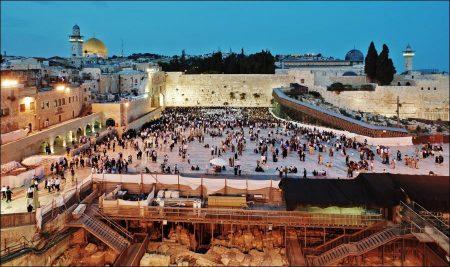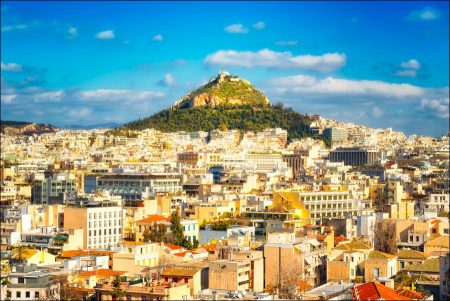
Cities that have stood the test of time reveal more than just the scars of history; they show the influence — positive and negative — of human civilization. The world’s oldest cities boast beautiful architecture and amazing stories, yet remarkably few ancient cities stand today. There is some disagreement about the historical record, so we’ve added a few cities to the list below because of their cultural significance.
These cities, contenders for the 20 oldest continually-inhabited places on Earth, are about as close as you can get to time travel on holiday. Not all are safe to visit, however. Check the latest Foreign Office advice before planning a trip.
1. Jericho, Palestinian Territories
When did the earliest inhabitants settle? 9,000 BC.
The world’s oldest continually-inhabited city, according to our sources, archaeologists have unearthed the remains of 20 successive settlements in Jericho, dating back 11,000 years. The city is found near the Jordan River in the West Bank and is today home to around 20,000 people.
Can I go? The Foreign Office advises not.
2. Byblos, Lebanon
When did the earliest inhabitants settle? 5,000 BC.
Founded as Gebal by the Phoenicians, Byblos was given its name by the Greeks, who imported papyrus from the city. Hence the English word Bible is derived from Byblos. The city’s key tourist sites include ancient Phoenician temples, Byblos Castle and St John the Baptist Church – built by crusaders in the 12th century – and the old Medieval City Wall. The Byblos International Festival is a more modern attraction, and has featured bands such as Keane and Jethro Tull.
3. Aleppo, Syria
When did the earliest inhabitants settle? 4,300 BC.
Syria’s most populated city, with around 4.4 million citizens, Aleppo was founded as Halab in around 4,300 BC. As the ancient site is occupied by the modern city it is barely touched by archaeologists. The city was under Hittite control until around 800 BC, before passing through Assyrian, Greek and Persian hands. It was later occupied by the Romans, Byzantines and Arabs, besieged by the Crusaders and then taken by the Mongols and Ottomans. Many of the city’s architectural gems have been devastated by recent conflict.
Can I go? The Foreign Office advises not.
4. Damascus, Syria
When did the earliest inhabitants settle? 4,300 BC.
Cited by some sources as the world’s oldest inhabited city, Damascus may have been inhabited as early as 10,000 BC, also this is debated. It became an important settlement after the arrival of the Aramaeans, who established a network of canals, which still form the basis of its modern water networks. Another of Alexander the Great’s conquests, Damascus has since been in Roman, Arab and Ottoman possession. Its wealth of historical attractions made it a popular tourist destination, until recent unrest struck.
Hilaire Belloc (English-French writer and historian): “Damascus is… a symbol. One might call it a bunch of symbols. It is a symbol of the permanent physical conditions that run throughout history; the permanent geographical limits of human settlement, government and war.”
Can I go? The Foreign Office advises not.
5. Susa, Iran
When did the earliest inhabitants settle? 4,200 BC.
Susa was the capital of the Elamite Empire before being captured by the Assyrians. It was then taken by the Achaemenid Persian under Cyrus the Great and is the setting of The Persians, an Athenian tragedy by Aeschylus and the oldest surviving play in the history of theatre. The modern city, Shush, has a population of around 65,000.
Francis Bacon (1st Viscount St. Alban; English philosopher and author): “Persia, a country imbarred with mountains, open to the sea, and in the middle of the world.”

6. Faiyum, Egypt
When did the earliest inhabitants settle? 4,000 BC.
Southwest of Cairo, Faiyum occupies part of Crocodilopolis – an ancient Egyptian city which worshipped Petsuchos, a sacred crocodile. Modern Faiyum consists of several large bazaars, mosques and baths, while the Lehin and Hawara pyramids are found nearby.
Herodotus (Greek historian): “Egypt is an acquired country, the gift of the river.”
Can I go? The Foreign Office advises not.
7. Sidon, Lebanon
When did the earliest inhabitants settle? 4,000 BC.
Around 25 miles south of Beirut lies Sidon, one of the most important – and perhaps the oldest – Phoenician cities. It was the base from which the Phoenician’s great Mediterranean empire grew. Both Jesus and St Paul are said to have visited Sidon, as did Alexander the Great, who captured the city in 333 BC.
Charles Méryon (French artist): “Few persons new to the climate escape a rash of some description.”
Can I go? The Foreign Office advises not.
8. Plovdiv, Bulgaria
When did the earliest inhabitants settle? 4,000 BC.
The second-largest city in Bulgaria, Plovdiv was originally a Tracian settlement before becoming a major Roman city. It later fell into Byzantine and Ottoman hands, before becoming part of Bulgaria. The city is a major cultural centre and boasts many ancient remains, including a Roman amphitheatre and aqueduct, and Ottoman baths.
Lucian (Roman writer): “This is the biggest and loveliest of all cities. Its beauty shines from faraway.”
9. Gaziantep, Turkey
When did the earliest inhabitants settle? 3,650 BC.
Found in southern Turkey, close to the border with Syria, Gaziantep’s history extends as far back as the Hittites. The Ravanda citadel – restored by the Byzantines in the sixth century – is found in the city centre, while Roman mosaics have also been discovered.
Samuel Taylor Coleridge (English poet and philosopher): “They have no past; they are not an historical people; they exist only in the present.”
Can I go? The Foreign Office advises not.
10. Beirut, Lebanon
When did the earliest inhabitants settle? 3,000 BC.
Lebanon’s capital, as well as its cultural, administrative and economic centre, Beirut’s history stretches back around 5,000 years. Excavations in the city have unearthed Phoenician, Hellenistic, Roman, Arab and Ottoman remains, while it is mentioned in letters to the pharaoh of Egypt as early as the 14th century BC. Since the end of the Lebanese civil war, it has become a lively, modern tourist attraction.
Jan Morris (Welsh historian and travel writer): “To the stern student of affairs, Beirut is a phenomenon, beguiling perhaps, but quite, quite impossible.”

11. Jerusalem, Israel
When did the earliest inhabitants settle? 2,800 BC.
The spiritual centre of the Jewish people and Islam’s third-holiest city, Jerusalem is home to several key religious sites, including the Dome of the Rock, the Western Wall, the Church of the Holy Sepulchre and the al-Aqsa Mosque. During its history, the city has been besieged 23 times, attacked 52 times, captured 44 times and destroyed twice.
Benjamin Disraeli (1st Earl of Beaconsfield; former prime minister): “The view of Jerusalem is the history of the world; it is more, it is the history of earth and of heaven.”
12. Tyre, Lebanon
When did the earliest inhabitants settle? 2,750 BC.
The legendary birthplace of Europa and Dido, Tyre was founded around 2,750 BC, according to Herodotus. It was conquered by Alexander the Great in 332 BC following a seven-month seige and became a Roman province in 64 BC. Today, tourism is a major industry: the city’s Roman Hippodrome is a Unesco World Heritage Site.
The Bible mentions the city: “Tyre, the crowning city, whose merchants are princes.”
13. Arbil, Iraq
When did the earliest inhabitants settle? 2,300 BC.
North of Kirkuk lies Arbil, ruled at various times by the Assyrians, Persians, Sasanians, Arabs and Ottomans. It was a major stop on the Silk Road while its ancient citadel – which rises 26 metres from the ground – still dominates the skyline.
Can I go? The Foreign Office advises not.
14. Kirkuk, Iraq
When did the earliest inhabitants settle? 2,200 BC.
Located around 150 miles north of Baghdad, Kirkuk stands on the site of the ancient Assyrian capital of Arrapha. Its strategic importance was recognised by the Babylonians and the Media, who have also controlled the city. The ruins of a 5,000-year-old citadel are still visible, while the city is now the headquarters of Iraq’s petroleum industry.
Can I go? The Foreign Office advises not.
15. Balkh, Afghanistan
When did the earliest inhabitants settle? 1,500 BC.
Known as Bactra to the ancient Greeks, Balkh is found in northern Afghanistan and is descibed as the ‘Mother of Cities’ by Arabs. It reached its peak between 2,500 BC and 1,900 BC prior to the rise of the Persian and Median empires. Modern Balkh is home to the region’s cotton industry.
W.C. Fields (American actor and writer): “During one of my treks through Afghanistan, we lost our corkscrew. We were compelled to live on food and water for several days.”
Can I go? The Foreign Office advises not.

16. Athens, Greece
When did the earliest inhabitants settle? 1,400 BC.
The cradle of Western Civilization and the birthplace of democracy, Athens’s heritage is still very evident. It is filled with Greek, Roman, Byzantine and Ottoman monuments and remains a hugely popular tourist destination.
Alexander the Great: “How great are the dangers I face to win a good name in Athens.”
17. Larnaca, Cyprus
When did the earliest inhabitants settle? 1,400 BC.
Founded as ‘Citium’ by the Phoenicians, Larnaca is well-known for its pretty seafront lined with palm trees. Archaeological sites and numerous beaches attract modern visitors.
Robert Byron (British travel writer): “History in this island is almost too profuse. It gives one a sort of mental indigestion”.
18. Thebes, Greece
When did the earliest inhabitants settle? 1,400 BC.
A major rival of ancient Athens, Thebes ruled the Boeotian confederacy and even lent assistance to Xerxes during the Persian invasion of 480 BC. Archaeological excavation has revealed a Mycenaean settlement dating back even further. Today, Thebes is little more than a market town.
John Milton (English poet): “Sometime let gorgeous Tragedy/ In sceptred pall come sweeping by/ Presenting Thebes, or Pelops’ line/ Or the tale of Troy divine.”
19. Cádiz, Spain
When did the earliest inhabitants settle? 1,100 BC.
Found on a narrow spit of land jutting out into the Atlantic Ocean, Cádiz has been the home of the Spanish navy since the 18th century. It was founded by the Phoenicians as a small trading post and fell to the Carthaginians around 500BC, becoming a base for Hannibal’s conquest of Iberia. It then came under Roman and Moorish rule, before experiencing a renaissance during the Age of Exploration.
Robert Browning, the English poet and playwright, wrote: “Nobly, nobly Cape Saint Vincent to the North-west died away/ Sunset ran, one glorious blood-red, reeking into Cádiz bay.”
20. Varanasi, India
When did the earliest inhabitants settle? 1,000 BC.
Situated on the west bank of the Ganges, Varanasi – also known as Benares – is an important holy city for both Hindus and Buddhists. According to legend, it was founded by the Hindu deity Lord Shiva 5,000 years ago, though modern scholars believe it to be around 3,000 years old.
Mark Twain (American author): “Benares is older than history, older than tradition, older even than legend, and looks twice as old as all of them put together.”
Views: 133


